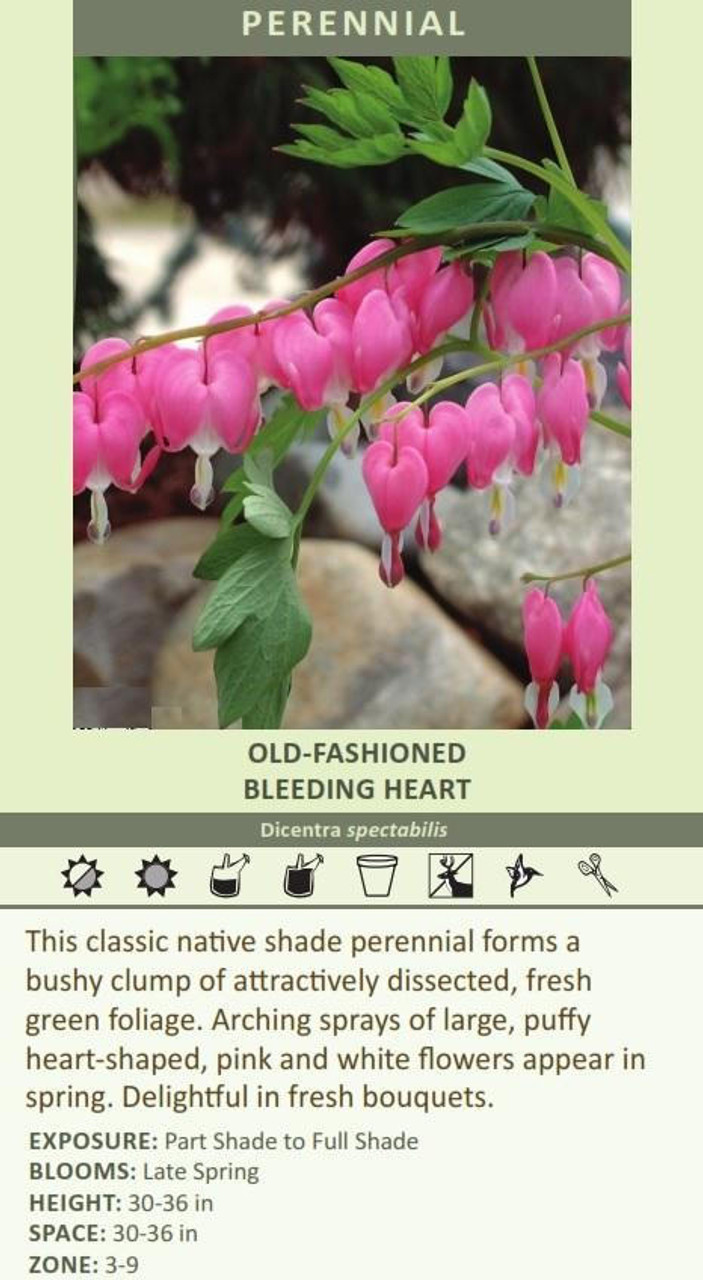Product Description
Dicentra spectabilis (4) 1-gallons
a/k/a Bleeding Heart
Zones 3 to 9.
Part shade to full shade.
Mature size 30-to-36-inch height, spreads 30 to 36 inches.
Large, bushy clumps of powdery-green foliage comprised of cut or lobed leaves on fleshy stems. In late spring, chains of puffy heart-shaped flowers with rose-pink petals and white tips dangle beneath the arching, leafless stems. Fresh bouquets will last about 2 weeks in a vase. In cooler climates with adequate moisture, the bloom time may be extended into early summer.
After flowering, Old-Fashioned Bleeding Hearts usually go dormant until the following spring. However, if plants are kept well-watered during the spring, dormancy may be delayed until late summer or early fall.
Dicentra spectabilis, commonly known as Bleeding Heart, is a beloved and old-fashioned garden favorite. It is treasured for its graceful arching stems and delicate, heart-shaped flowers that dangle like lockets. Here is a closer look at what makes this perennial so special:
Appearance:
- Flowers: The most striking feature of Bleeding Heart is its unique, heart-shaped flowers. The flowers are typically a vibrant pink with a white, inner petal that protrudes like a drop of blood, giving the plant its common name. They bloom in late spring to early summer on long, arching racemes that dangle gracefully above the foliage.
- Foliage: The plant has attractive, deeply-cut, fern-like foliage that emerges a soft green color and adds a delicate texture to the garden.
Growing Conditions:
- Light: Thrives in partial shade to full shade. It can tolerate some sun, especially in cooler climates, but it prefers protection from the hot afternoon sun.
- Soil: Prefers moist, well-drained soil that is rich in organic matter. It is not too fussy about soil pH but does best in neutral to slightly alkaline conditions.
- Hardiness Zones: Hardy in USDA zones 3-9, making it suitable for a wide range of climates.
Uses:
- Woodland Gardens: Its natural habitat is in moist woodlands, so it is a perfect addition to woodland gardens or shaded areas under trees.
- Shade Gardens: Bleeding Heart is a classic choice for shade gardens, where its delicate flowers and foliage add a touch of elegance.
- Borders: It can also be used in mixed borders, but it is important to place it towards the front or middle, as it tends to go dormant in mid-summer after flowering.
- Cut Flowers: The unique flowers make lovely additions to fresh bouquets.
Additional Benefits:
- Deer and Rabbit Resistant: The foliage is generally unappealing to deer and rabbits.
- Low Maintenance: It is a relatively low-maintenance plant that does not require much care once established.
Things to Consider:
- Summer Dormancy: Bleeding Heart often goes dormant in mid-summer after flowering, especially in hot or dry conditions. It is a good idea to plant it among other perennials that will fill in the space when it dies back.
- Toxicity: The plant contains toxins that can cause mild stomach upset if ingested, so it is best to keep it away from children and pets.
Overall, Dicentra spectabilis (Bleeding Heart) is a charming and elegant perennial that is perfect for adding a touch of romance to shade gardens. Its unique flowers, delicate foliage, and adaptability make it a beloved choice for gardeners of all levels.
(4) 1-gallon containers ready to plant, plants may be trimmed for shipping,
Other Details
The most important part of the plant is its root system. Healthy roots are the foundation of a healthy, vibrant plant. The type of plug container used is based on the specific needs of the plants. Perennials offered as bare root traditionally perform better when planted as bare root.Planted in a specialized mix, potted plants have well established root systems. Top growth stage will vary depending on the current life cycle and time of year when shipped. In Winter and early Spring dormant plants may be shipped. Dormant plants may be planted right away, even before the last frost date.
Most bare root varieties are field grown for at least one season, though Hemerocallis and Hosta are grown for two seasons. The bulk of the soil is removed during the harvesting process and the tops of most varieties are trimmed back to the crown. They are graded, packed in shredded aspen or sphagnum moss and stored in freezers until ready to be shipped.
See our Container Sizes and Bare Root Perennials pages for more information.
Plant information and care is provided in the Overview section, Plant Genus Page and general information is provided in the Planting Care & Guides. Additional questions can be asked on each Plant page.
Plant Spacing: Using the maximum mature spread or width of a plant to guide spacing, ensures space to grow to full size. To fill an area sooner, plant them closer together. Just remember, future thinning or transplanting may be needed.
Water: Keep a close eye on newly planted perennials, especially throughout the first growing year. Most early plant loss is due to too much or too little water!
















